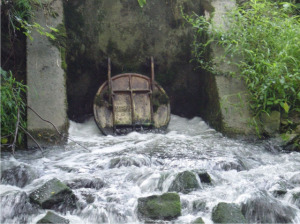Las impurezas del Radionuclide dan vuelta para arriba en aguas residuales
por
Brendon Nafziger, DOTmed News Associate Editor | July 20, 2010

Impurities from nuclear medicine
procedures might end up here.
Impurities from radiopharmaceuticals end up in wastewater in tiny but detectable quantities, according to a paper presented at the American Association of Physicists in Medicine's annual conference on Sunday.
When the radioisotope molybdenum-99 is milked into technetium-99m, which is used in nuclear medicine scans, trace amounts of moly and the radionuclide ruthenium-103 can remain in the resulting radiopharmaceutical. These in turn can get passed out into the wastewater, the study found.
While it was known that trace amounts of technetium-99m could wind up in sewage, this is the first study to see if impurities from the radiopharmaceuticals could be found there, Tristan Hay, a researcher at Oregon State University and lead author of the study, told DOTmed News.
In the study, Hay sampled sewage at a treatment plant in his university's hometown of Corvallis, Ore., using an HPGe detector. He compared the samples from processed sewer sludge against ones from used radiopharmaceutical syringes at health centers in the city as well as with tap water.
While he hasn't fully quantified the results yet, he did discover trace amounts of the radioactive materials in the sewage that matched the products used by the health centers. However, there appears to be no safety concern: none of the medical radionuclides appeared in the tap water, and the ones that showed up in the sewer sludge were at levels well below the background rate of radioactive materials found naturally in waterways, Hay said.
Tc-99m, with a half-life of about six hours, and molybdenum-99, with a half-life of 66 hours, probably would never make it much past the treatment plant, anyway, Hay said, although ruthenium-103, with its 40-day half-life, could still be a concern.
"The shorter-lived nuclides like technetium-99m will obviously decay off before they get to the river or the environment," Hay said. "But the longer-lived impurities such as ruthenium-103 have the possibility to make it past the wastewater system and out to the environment."
Although the amount was low, Hay wants to test wastewater from a bigger city -- Corvallis' population is only about 51,000 -- to see if the greater usage of radiopharmaceuticals could have more of an impact.
"If there's a bigger city, there's more of these small impurities making it out to the river," Hay said. "But again, it's probably quite small, from what I've seen so far."
